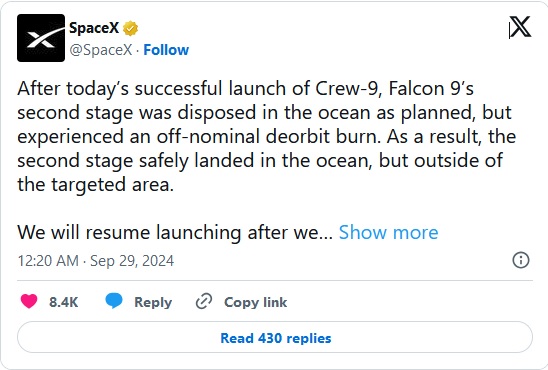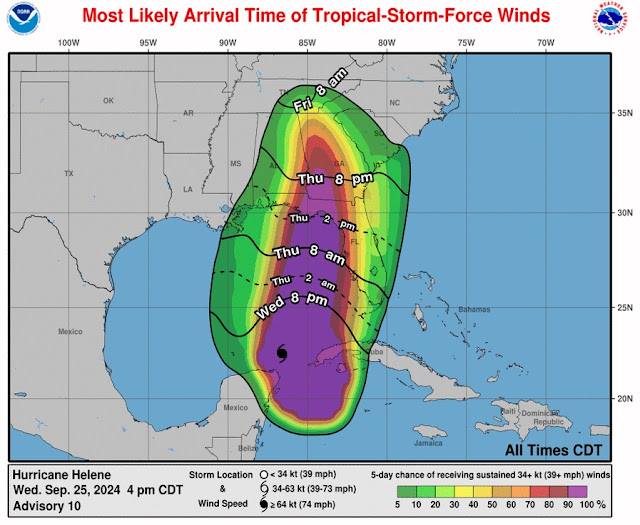It's a strange week, with SpaceX temporarily halting Falcon 9 launches. That means for the first time in memory, ULA is going to launch more than any other US launch provider. Typically, ULA launches as many in a year as SpaceX does in a week. OK, some years ago, ULA launched in a year a SpaceX month's worth, and their goal is to launch Vulcan 25 times/year.
The next launch in the US will be the Cert-2 flight for ULA's Vulcan on Friday morning, October 5, at 6:00 AM ET.
Given that, there are currently three rather rare astronomical events either
coming in the near future or currently happening. There's only one of the
three that can't realistically be thought of as a once in a lifetime, and
that's the last one. It's a "once every few years" event.
That comet is Tsuchinshan-ATLAS, a comet first sighted at China's Purple Mountain Observatory on Jan. 9, 2023 and independently verified on Feb. 22 by the Asteroid Terrestrial-Impact Last Alert System (ATLAS). Given that long name with a large part that most westerners wouldn't have a clue how to pronounce, it's widely being referred to simply as comet A3. The story early in September was that A3 was going to take its closest approach to the sun on the 27th of the month and since that often destroys the comet, I thought I'd wait to try and see it if it survives the pass by the sun. Well, it survived, and while it's in the predawn skies right now, it will be moving later into the evening skies as we go into October.
Comet A3 is moving to a position in between the Earth and the sun. On Sept. 27, comet A3 reached its perihelion — the closest it gets to the sun — at about 36 million miles (59 million km). Comet A3 will get closest to Earth on Oct. 12, when it will pass about 44 million miles (71 million km) from Earth.
That link at the end of the previous paragraph to Forbes magazine is something
I stumbled across that includes a long section toward the bottom that helps
you figure out where to look. If you'd like to play with a
planetarium-style program to see where it will be from where you are, consider
Stellarium's open web app.
Frankly, I haven't paid much attention to this story because I couldn't begin to list the number of times I got suckered in by talk about how bright a comet was going to be, only to have it not live up to the hype. As it is, this is barely a naked eye comet. It might get brighter and it might not.
The second one is very likely a once in a lifetime event because it's a recurring event that comes around every 80 years. Some child around 8 or 10 could conceivably see this one and the next one, given some luck and medical advances.
That's the recurring nova - star explosion - of a dim star called T Coronae Borealis or T CrB. When it goes off, it will be visible to the naked eye, a new star - the reason for the word "nova" after all.
Already, the stellar remnant, a white dwarf called T Coronae Borealis that's feasting on material from a nearby red giant star, has revealed a tell-tale dip in brightness that "is right on top" of the one that preceded its previous outburst in 1946. Astronomers don't yet know for sure what's causing the dip, but they say it's just a matter of time before the nova satiates its hunger and explodes into a spectacular nova. "We know it's going to go off — it's very obvious," Edward Sion, a professor of astronomy and astrophysics at Villanova University in Pennsylvania, told Space.com.
An artist's concept of the binary star system known as T Coronae Borealis, in which a white dwarf star will burst with bright light after siphoning material from its larger red giant star companion. (Image credit: NASA's Goddard Space Flight Center)
While this sort of nova has been known of for a long time, and this particular star's case as well, there were no X-ray or gamma-ray telescopes in space 80 years ago, the last time the nova erupted. All of this will be new information.
T Cor Bor is being watched by NASA's Fermi gamma-ray space telescope every day — and, most of the time, every few hours. As soon as the nova erupts, gamma rays will skyrocket alongside a similar spike in the nova's brightness, allowing astronomers to decipher just how hot material is getting soon after the eruption, and how fast that material blows away from the white dwarf. Astronomers are also eager to learn more about how shock waves will whiz through space in the moments following the explosion, the specifics of which are not very well understood.
Finally, a once or twice in a lifetime story (I've been interested in astronomy since I was about 12, and it's the first I know of). I mention it because you might have seen the fun headlines that the Earth has captured a second moon. It should have done that on Sunday.
This temporary, and so far from Earth it won't complete a single orbit before it "escapes" from us again.
"According to the latest data available from NASA's Jet Propulsion Laboratory Horizons system, the temporary capture will start at 15:54 EDT (1954 UTC) and will end at 11:43 EDT (1543 UTC) on November 25," mini-moon event expert and Universidad Complutense de Madrid professor Carlos de la Fuente Marcos told Space.com on Wednesday (Sept. 25).
I read over the weekend that this is not only far too dim to be a naked eye
object, but if you're a hobbyist with a 10 or 12" reflector - the largest
common sizes - you still won't see it. This is an event for 30" or
larger observatory telescope, with very sensitive CCD imagers. Face it.
We ain't seeing it with our eyes and a telescope. Unless you work on Mt.
Palomar or something.




















